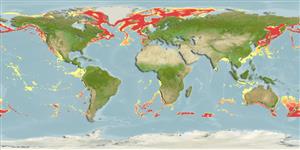分類 / Names
俗名 | 同種異名 | Catalog of Fishes(屬, 種) | ITIS | CoL | WoRMS | Cloffa
Elasmobranchii
板鰓亞綱 (鯊魚與魟魚) (sharks and rays) >
Rajiformes (Skates and rays)
鰩目 (Skates and rays) >
Rajidae (Skates)
鰩科 (Skates)
Etymology: Amblyraja: Greek, amblys = darkness + Latin, raja, -ae = ray (Raja sp.) (Ref. 45335).
Environment: milieu / climate zone / depth range / distribution range
生態學
海洋 深海底的; 深度上下限 92 - 2925 m (Ref. 119696), usually 300 - 2300 m (Ref. 9261). 深水域; -1°C - 4°C (Ref. 119696); 82°N - 50°S, 180°W - 180°E
Arctic, Indian, Pacific and Atlantic oceans: in cold and deep waters.
東北大西洋: 斯匹次卑爾根群島到格陵蘭-冰島-法蘭群島- 雪特蘭群島海脊到挪威北部。 西北大西洋: 在格陵蘭西南方與加拿大之間的戴維斯海峽。 東南大西洋: 南非的最南端.(參考文獻 6871) 東印度洋: 外海的澳洲南部.(參考文獻 6871) 西南太平洋: 紐西蘭.(參考文獻 6871) 東太平洋: 哥斯大黎加,巴拿馬,哥倫比亞與厄瓜多.(參考文獻 6871)
Length at first maturity / 大小 / 重量 / 年齡
Maturity: Lm ?, range 94 - ? cm
Max length : 112 cm TL 雄魚/尚未辨別雌雄; (Ref. 114953); 100.0 cm TL (female)
簡短描述
檢索表 | 型態特徵 | 形態測量圖
Grey-brown with large dark blotches (Ref. 26346). Tail very short (Ref. 26346). Mid-dorsal row of stout thorns which extend from nuchal region to first dorsal fin. Thorns close posterior to the pelvic girdle larger than along the tail (Ref. 6902). Upper surface dark mouse gray, dark blue gray or dark brown with small rounded spots. Lower surface white and sooty in variable patterns (Ref. 6902).
灰褐色有大的黑色斑塊.(參考文獻 26346) 尾部非常短的.(參考文獻 26346) 從頸背的區域到第一背鰭延伸的背部中央的矮棘列。 刺前面靠近腰帶大於沿著尾部.(參考文獻 6902) 上表皮深鼠灰色的﹐深藍灰色或深褐色的有小圓形的斑點。 下表面白色與烏黑的形成可變的樣式.(參考文獻 6902)
Found on the lower continental slope (Ref. 6871), probably most common on deep slopes and at abyssal depths (Ref. 114953). Benthic (Ref. 58426); meso- to bathybenthic, on muddy substrate (Ref. 119696). Adults feed on all kinds of bottom animals (Ref. 3167). Prefer polar temperatures from hatching to maturity and eggs are incubated successfully and regularly in water as cold as 0°C (Ref. 6902). Oviparous. Distinct pairing with embrace. Young may tend to follow large objects, such as their mother (Ref. 205). Eggs are oblong capsules with stiff pointed horns at the corners deposited in sandy or muddy flats (Ref. 205). Egg capsule measures 81-125 mm long and 50-80 mm wide (Ref. 41251). Hatching size at 16-18 cm TL (Ref. 114953) (15 cm long in Ref. 119696).
棲息於下面的大陸斜坡.。 (參考文獻 6871) 底棲的.(參考文獻 58426) 捕食各種的底部動物。 (參考文獻 3167) 從孵化對成熟偏愛兩極的溫度,而且卵在水冷到 0 °C 中被成功地而且經常地孵化。 (參考文獻 6902) 卵生的。 明顯的成對出現。 幼魚可能傾向跟隨大的個體, 例如他們的母親.(參考文獻 205) 卵為長方形鞘囊具有僵硬的觸角沈積在沙灘或泥灘的角落.(參考文獻 205) 卵鞘有 81-125 mm 長與 50-80 mm 寬的長。 (參考文獻 41251)
Life cycle and mating behavior
成熟度 | 繁殖 | 產卵場 | 卵 | 孕卵數 | 仔魚
Oviparous, paired eggs are laid. Embryos feed solely on yolk (Ref. 50449). Distinct pairing with embrace. Young may tend to follow large objects, such as their mother (Ref. 205).東北大西洋: 斯匹次卑爾根群島到格陵蘭-冰島-法蘭群島- 雪特蘭群島海脊到挪威北部。 西北大西洋: 在格陵蘭西南方與加拿大之間的戴維斯海峽。 東南大西洋: 南非的最南端.(參考文獻 6871) 東印度洋: 外海的澳洲南部.(參考文獻 6871) 西南太平洋: 紐西蘭.(參考文獻 6871) 東太平洋: 哥斯大黎加,巴拿馬,哥倫比亞與厄瓜多.(參考文獻 6871)
McEachran, J.D. and K.A. Dunn, 1998. Phylogenetic analysis of skates, a morphologically conservative clade of elasmobranchs (Chondrichthyes: Rajidae). Copeia 1998(2):271-290. (Ref. 27314)
IUCN 瀕危狀態 (Ref. 130435: Version 2024-1)
無危 (LC) ; Date assessed: 16 August 2015
人類使用
漁業: 沒有興趣
工具
特別的報告
下載 XML
網路資源
Estimates based on models
Preferred temperature (Ref.
123201): 0.3 - 8.8, mean 3.3 °C (based on 3242 cells).
Phylogenetic diversity index (Ref.
82804): PD
50 = 0.5010 [Uniqueness, from 0.5 = low to 2.0 = high].
Bayesian length-weight: a=0.00302 (0.00141 - 0.00645), b=3.24 (3.07 - 3.41), in cm total length, based on LWR estimates for this (Sub)family-body shape (Ref.
93245).
營養階層 (Ref.
69278): 4.3 ±0.5 se; based on diet studies.
回復力 (Ref.
120179): 低的, 最小族群倍增時間4.5 - 14 年 (Fec assumed to be <100).
Fishing Vulnerability (Ref.
59153): High to very high vulnerability (67 of 100).
Climate Vulnerability (Ref.
125649): Moderate vulnerability (38 of 100).
Nutrients (Ref.
124155): Calcium = 3.31 [0.50, 67.94] mg/100g; Iron = 0.302 [0.029, 4.121] mg/100g; Protein = 15.3 [13.3, 17.3] %; Omega3 = 0.494 [0.199, 1.207] g/100g; Selenium = 20.6 [3.6, 97.8] μg/100g; VitaminA = 6.37 [0.45, 85.10] μg/100g; Zinc = 0.206 [0.013, 2.410] mg/100g (wet weight);
